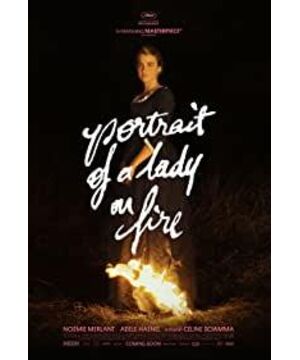"Portrait of a Burning Woman" is drawn from France in the 18th century and depicts the same-sex friendship between a painter and a rich lady in a closed utopia. From the 18th century to the early 20th century, whether in Europe, America or Asia, the memories of female writers were accompanied by stories of female homosexuality. Women's romantic friendships were called "Boston marriages" in 19th-century America, and "S" (the initials of "sister", meaning sister) in Japan in the early 20th century. Some women who have not yet entered into marriage, under the tide of women's liberation, choose not to marry for life, or even openly cohabit. "Portrait of a Woman on Fire" is the story of this period.
The film begins with memories. The painter, as the narrator, presents a painting of memories to the female students. Then the film enters memories. The protagonist, the painter, takes a boat to the rich mansion and meets the rich lady. The story ends with the "reunion" of the two. The two enjoyed the third movement of Vivaldi's "Four Seasons Summer" together in the concert. In the movie, the painter once asked the lady, have you heard orchestral music? The lady said no. In the movie, "memory" is also full of power. It is no longer the unchangeable past, it is integrated into the "present", the present is telling the story of the past, and the present is the collection of the past. Because of this, the orchestral music of the concert is both the present and the past, and the painting displayed in the exhibition, Miss holding the book (28 pages) from the past, the past also made the present.
Why so much emphasis is placed on the importance of "memory"? This is because in history, the writing of female homosexuality has always been inseparable from "memory". In many literary works, the narrator always tells about the "past" that was once and cannot be returned to. ', recalling previous romantic bonds between women. But critics have been negative about it. Here we give an example of Chinese literature, Lu Yin's "Li Shi's Diary" (published in "Fiction Monthly" in 1923), like the movie "Portrait of a Burning Woman", the protagonist Ruan Qing was forced to marry under family pressure. For the man she didn't love, she wrote to her girlfriend Li Shi, "Li Shi! Why didn't you make up your mind earlier, put on a man's dress, put on a man's hat, pretend to be a man, and propose to my family? ? Now people know that you are a woman, and they are not allowed to marry me, so they have to find out what kind of promising young people are here." In Li Shi's narration, her romance with Nguyen Thanh exists in dreams and memories.
I dreamed that there was a very elegant thatched hut next to a small stream. In front of the house, there were two large willow trees. It was a window with a slanting sun and white clouds closed the cave. Ruan Qing and I were sitting in this boat, riding the clear waves and gradually galloping into the reeds. At this time, a light rain started to fall in the sky. We were tightly covered by the reeds. We could not see the shape of the rain, but only heard the sound of the rain. After a long time, it was night. We hurriedly drove the boat back. The thin cool cloud was exposed, and the clear water was like emeralds. Ruan Qing asked me to go for a walk in the Crystal Palace.
When the dream wakes up, the memory returns to reality. The reality is the cold patriarchal society that cannot be changed and resisted. The "memory" becomes powerless, and the "memory" is just a silent sigh. But the movie "Portrait of a Burning Woman" re-writes the power of "memory", the power of women's self-expression, we see the story of Orpheus interspersed in the movie, but in the movie, it is no longer Russian Lupus looked back at his wife for the last time. It was the young lady who stopped the painter. Even if reality couldn't resist, memories would always have power. From this point of view, it can be said that the film "Portrait of a Woman on Fire" has drawn the best ending to all the stories of women's eroticism in history.
The movie ends with the sound of a cappella on the bonfire, a bonfire in the dark, and women sit around the bonfire and sing. In those days, women's self-expression was not allowed, only in the dark, in small picture frames , on the scratch paper, we can see their expressions. In the art exhibition, the heroine's own painting cannot even write her own name. But their voices, like chants by a campfire, will not go away.
View more about Portrait of a Lady on Fire reviews











